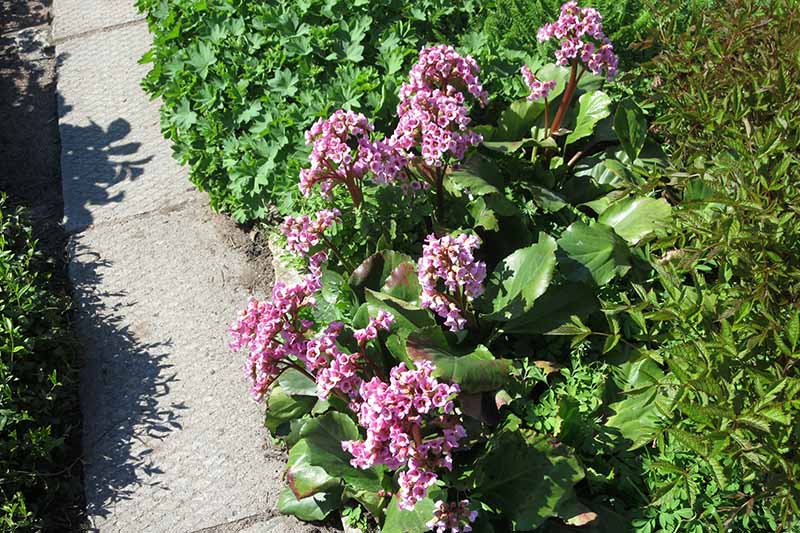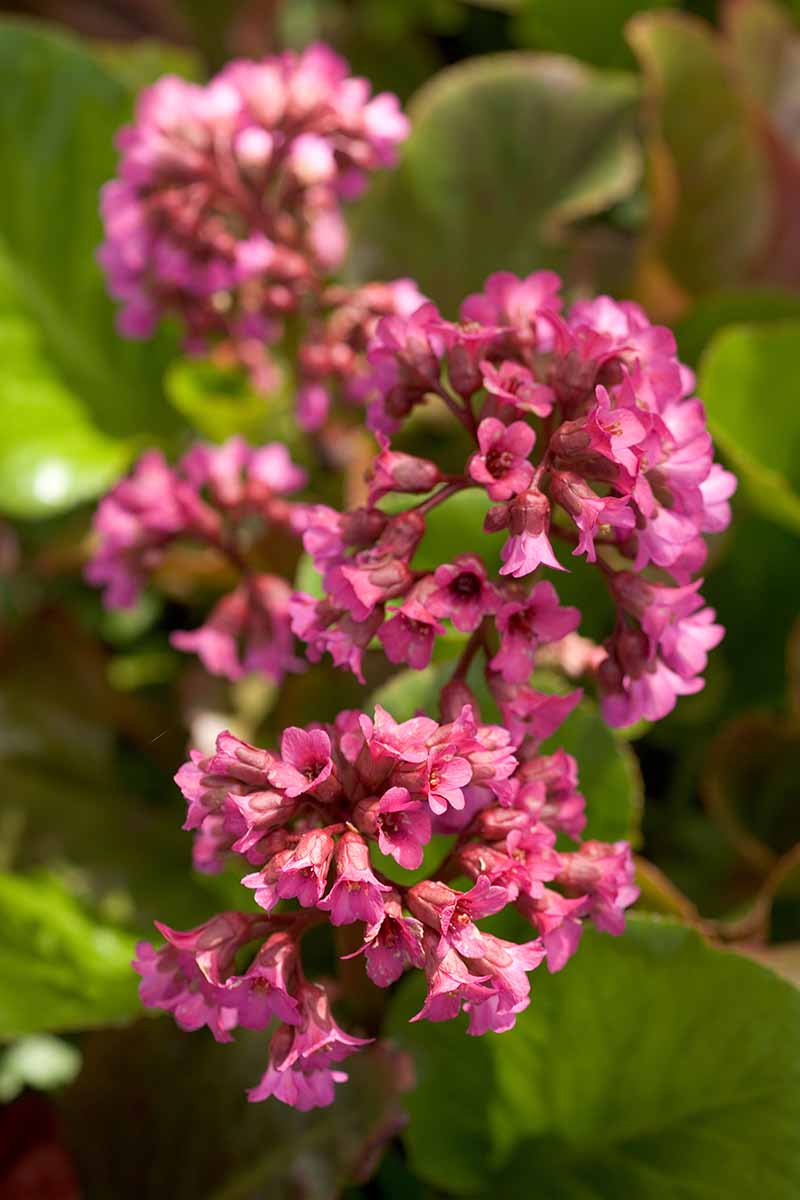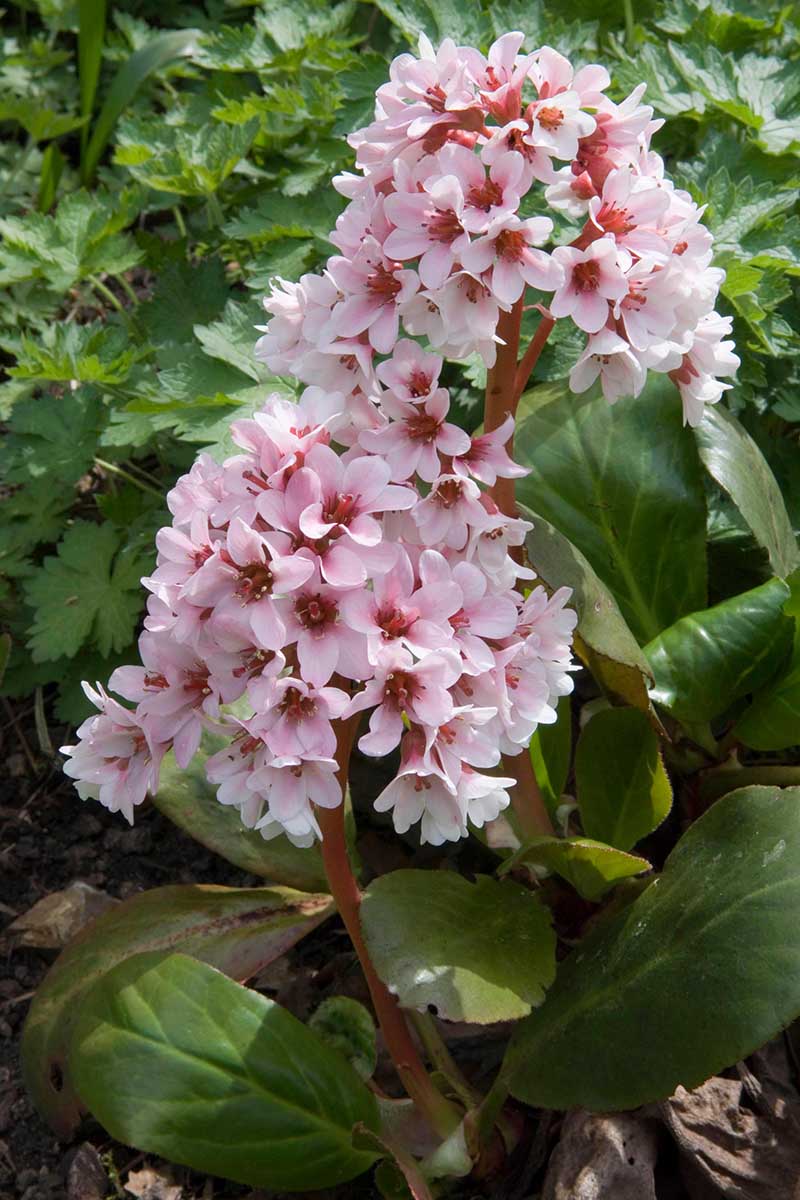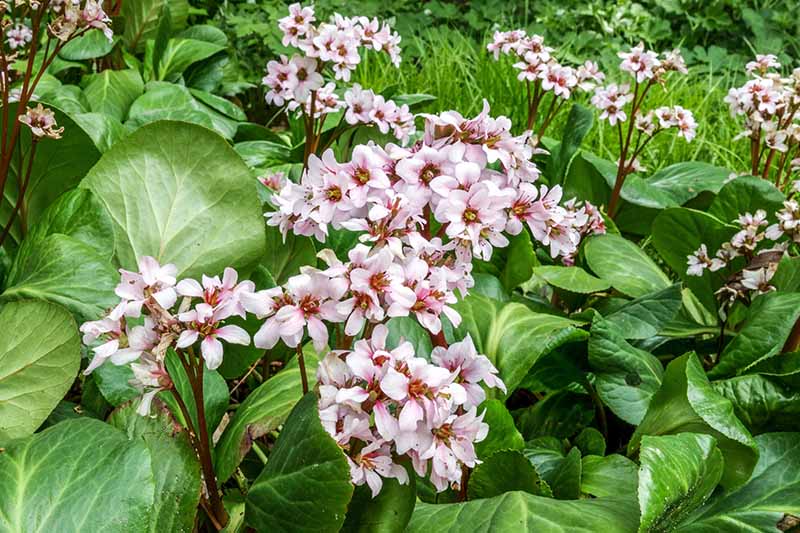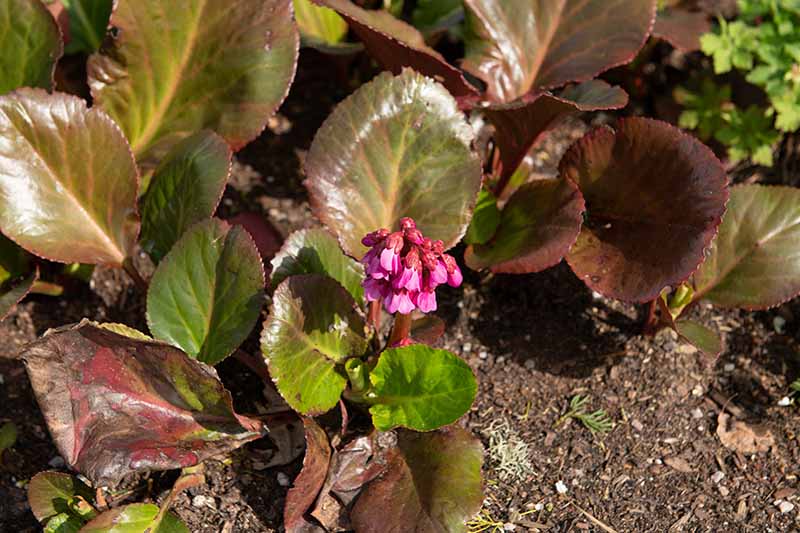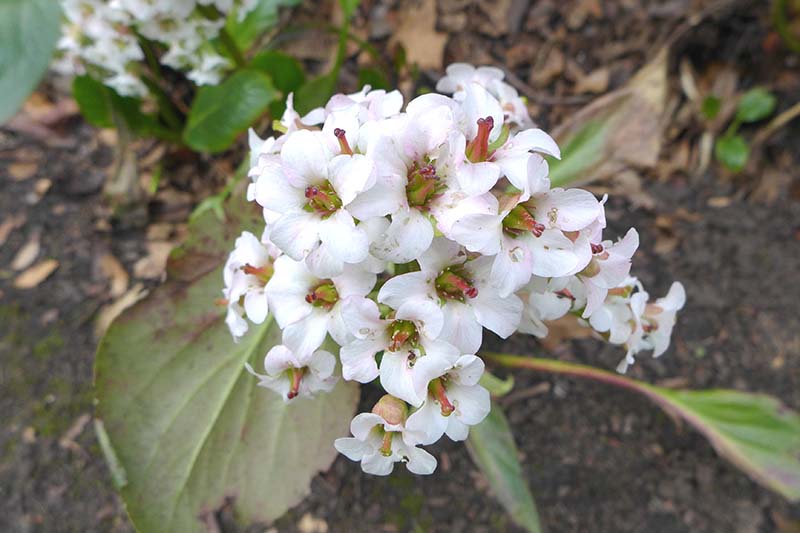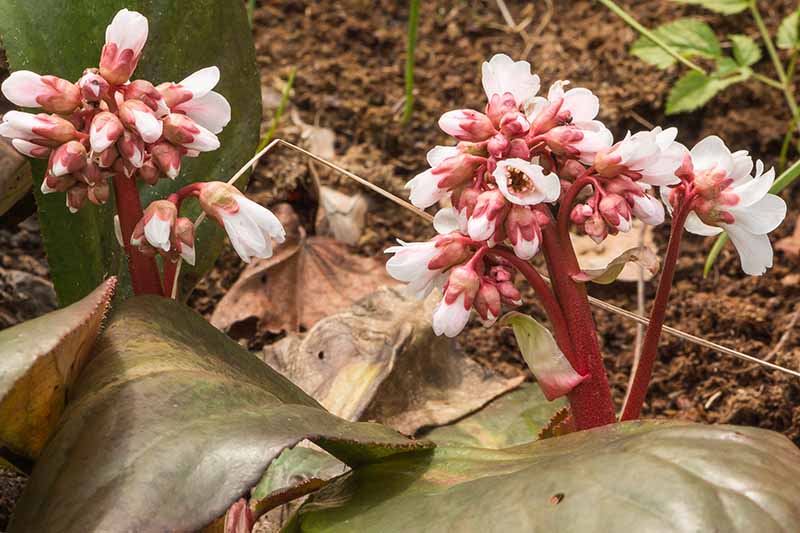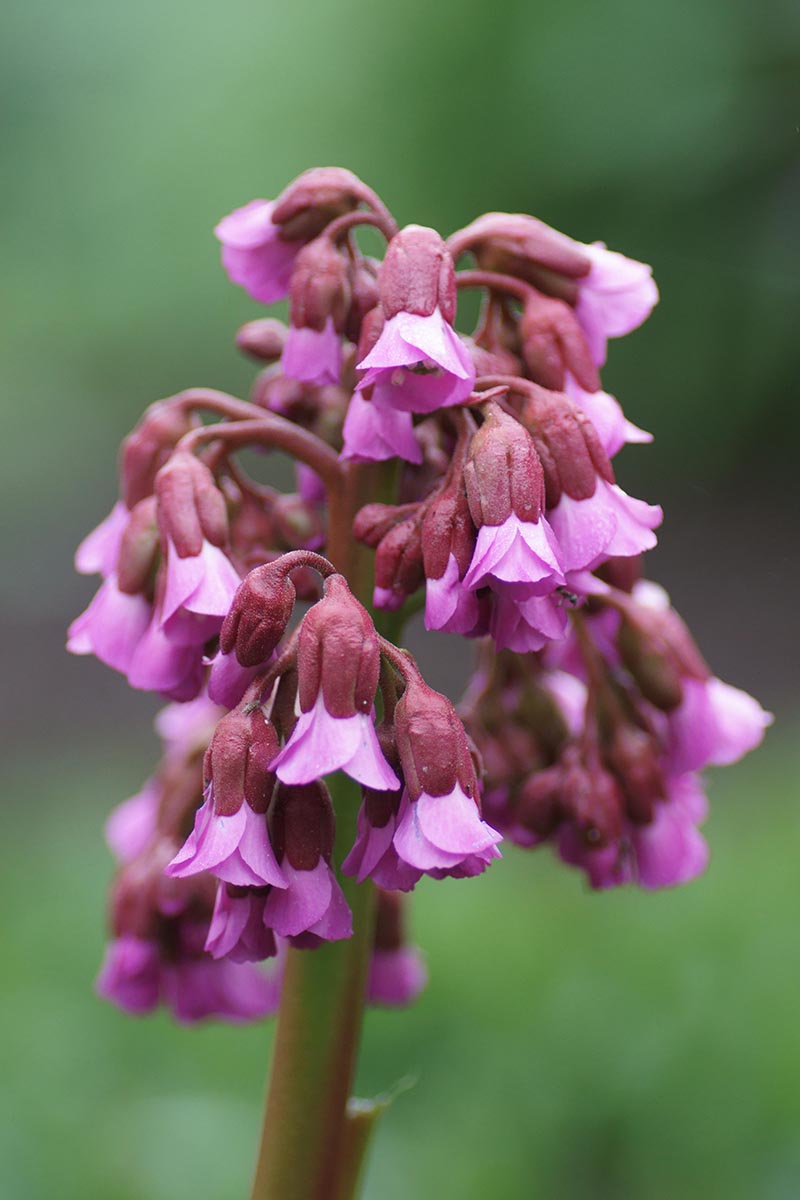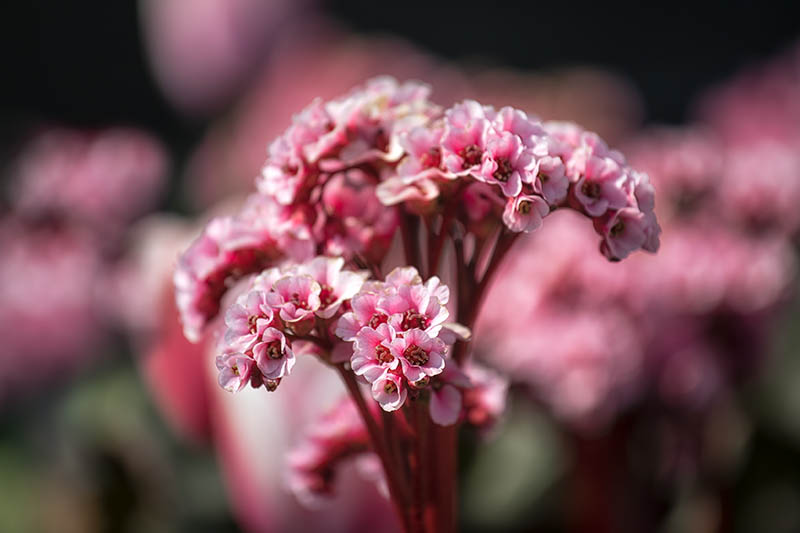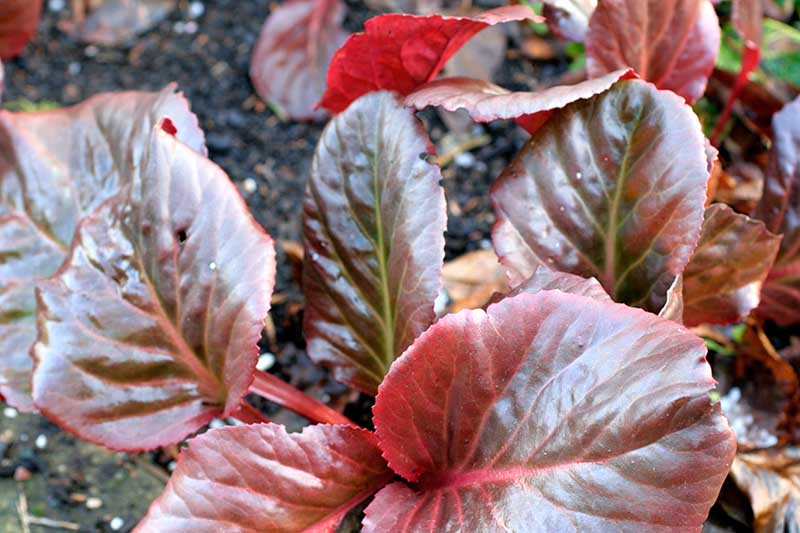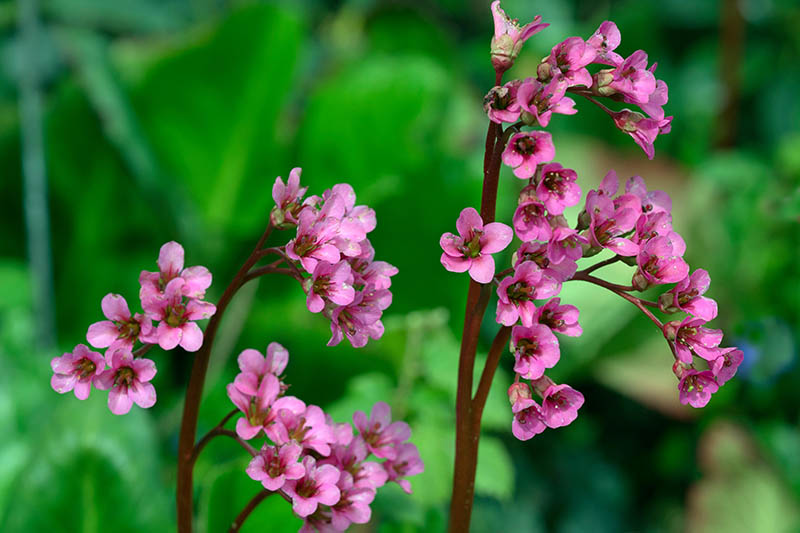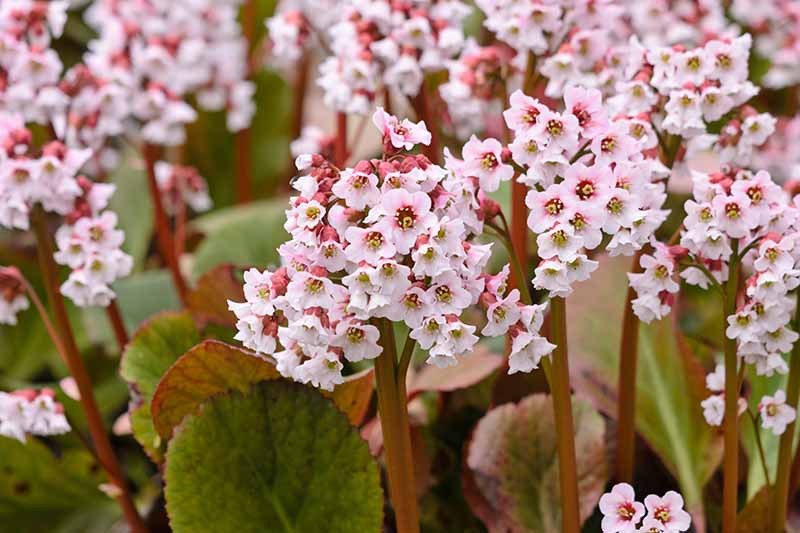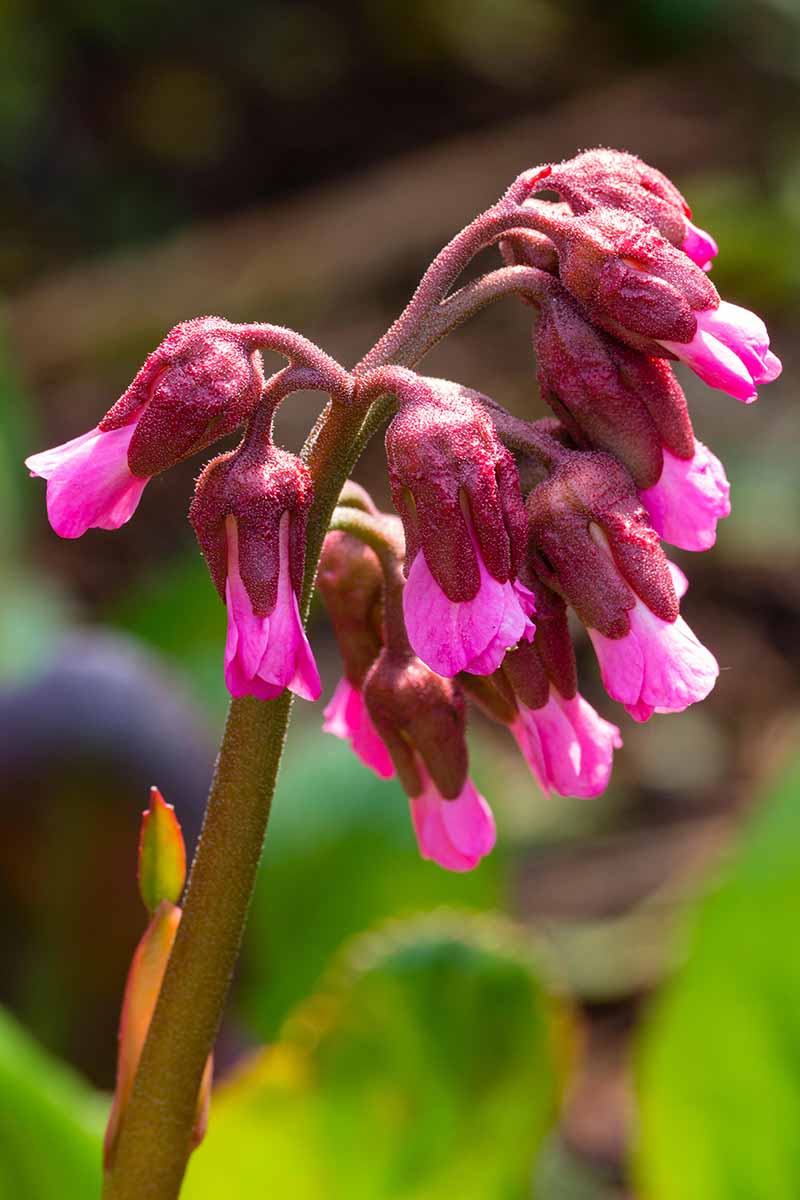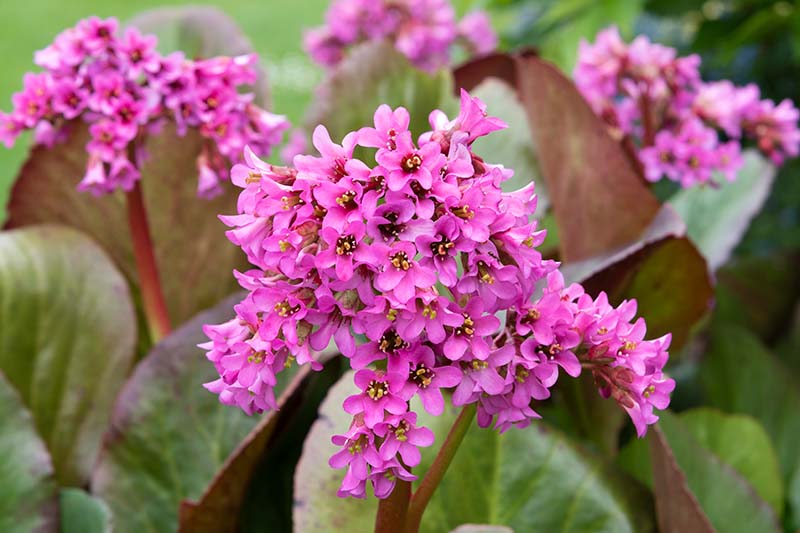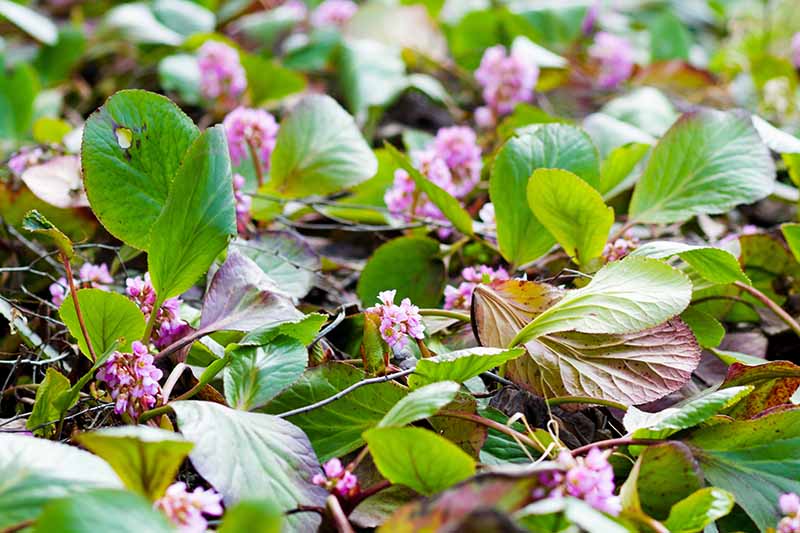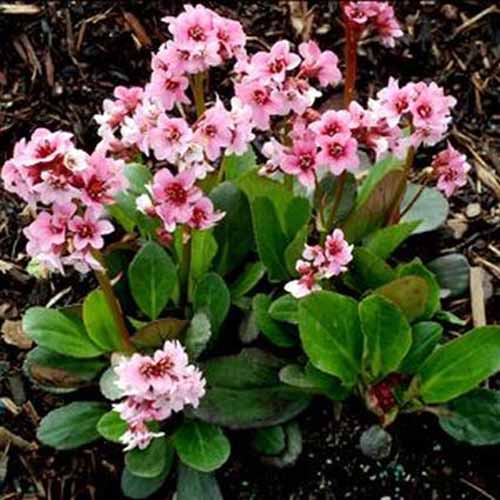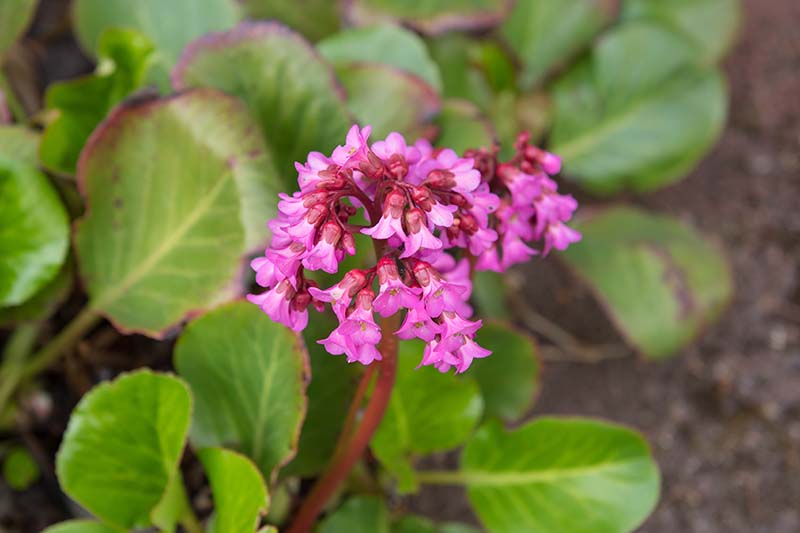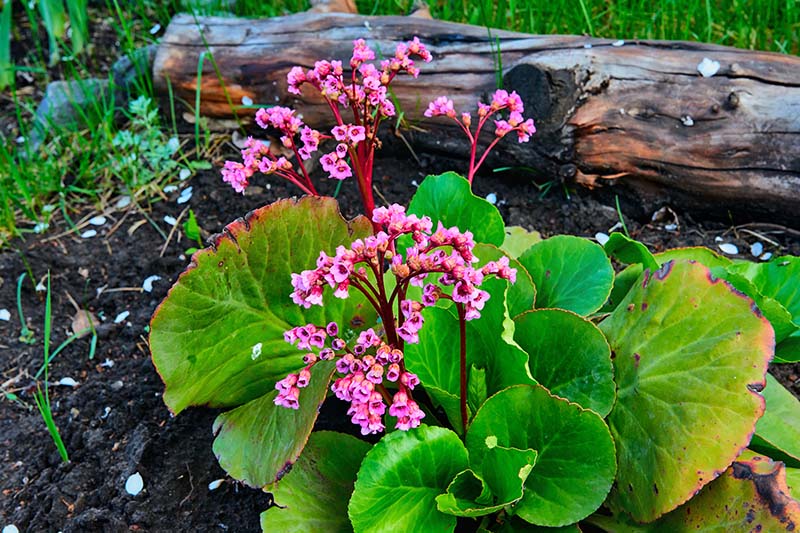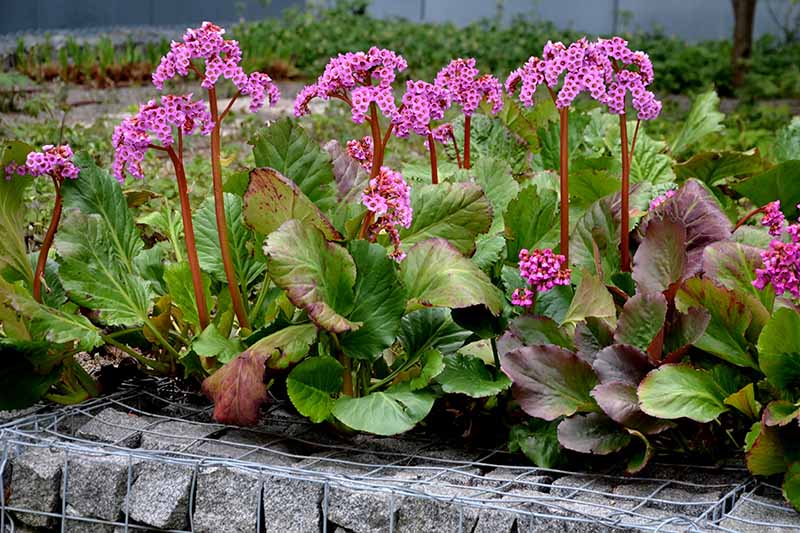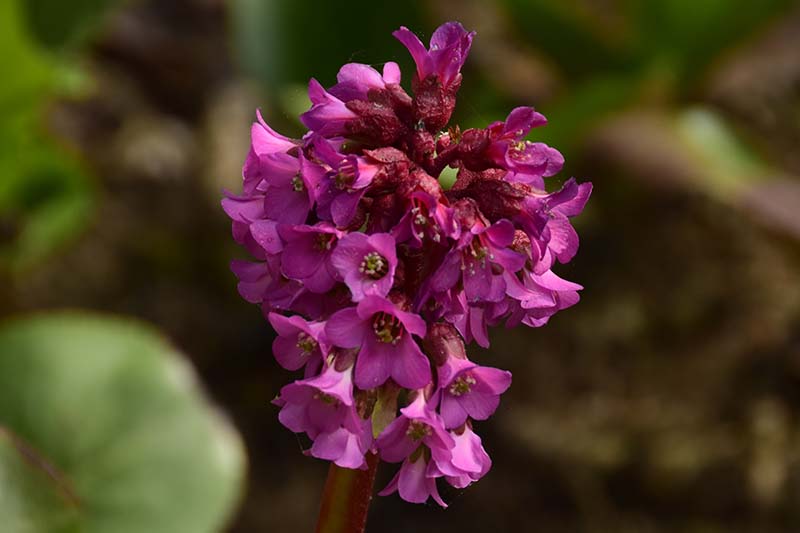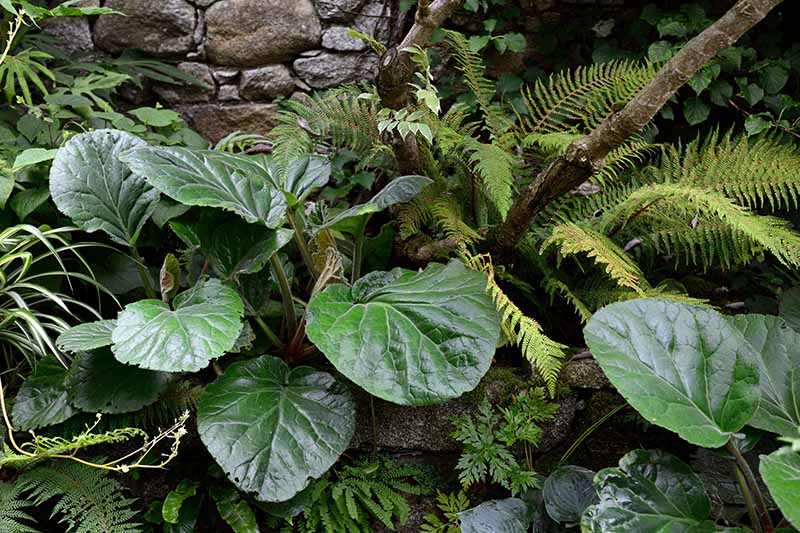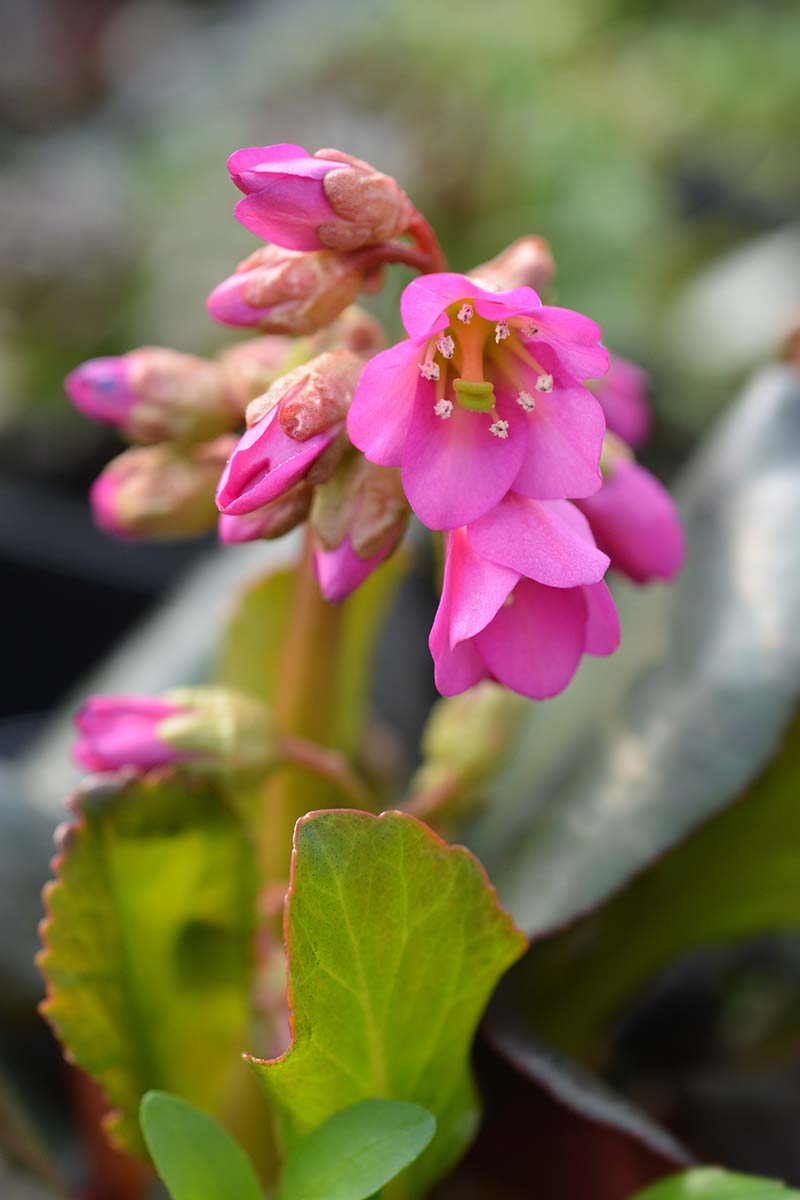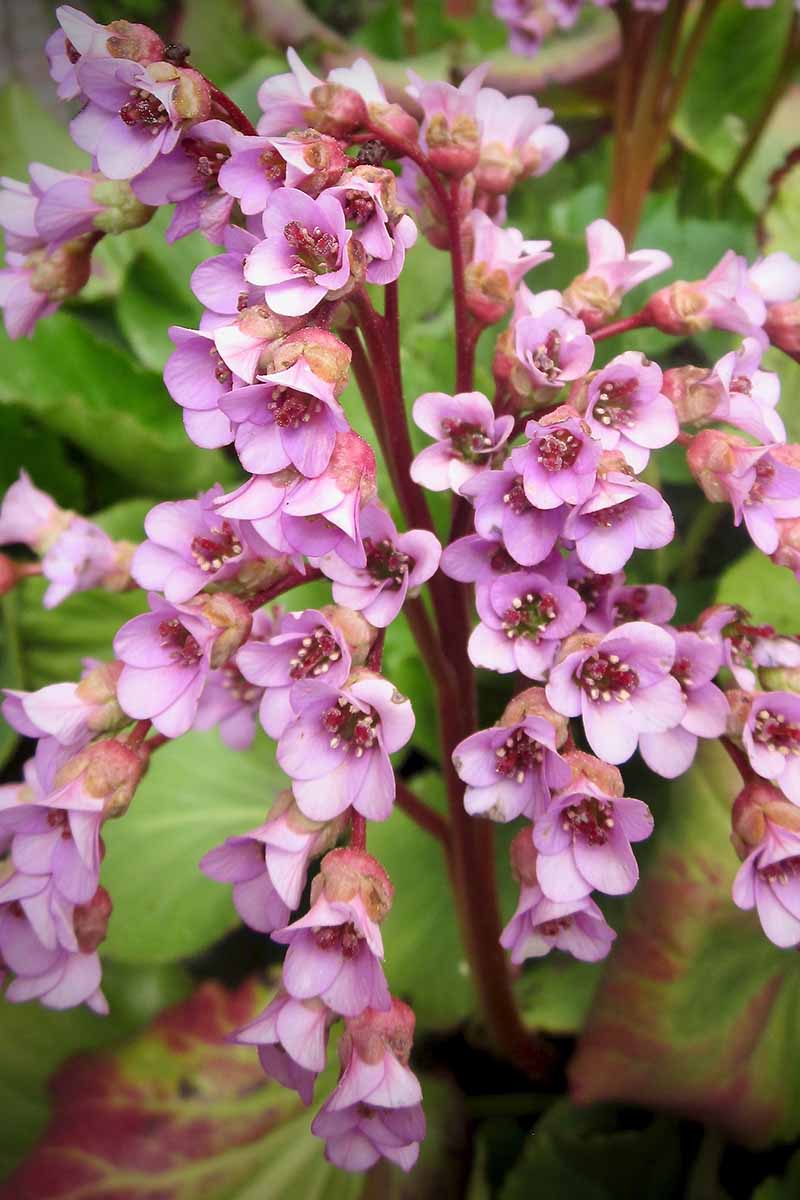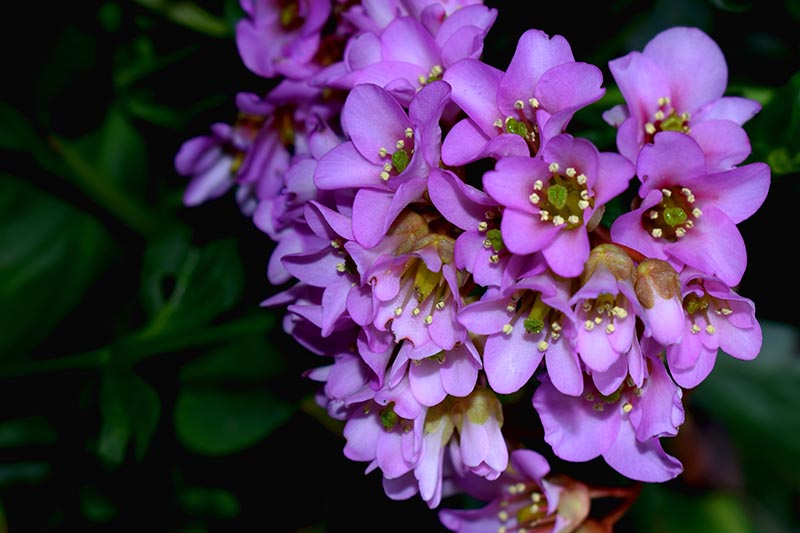As I always say, you can’t have too many plants! Honestly, I was shocked at the profusion of wonderful types of bergenia that are on the market. This is indicated by the 191 species, varieties, and cultivars that the British Royal Horticultural Society (RHS) deems worthy of its recommendation. We link to vendors to help you find relevant products. If you buy from one of our links, we may earn a commission. However, as tastes in plants have changed over time, and homeowners frequently have smaller gardens, bergenia breeders have been striving to create plants with smaller leaves and larger flowers. And they have succeeded! Another goal of breeders is to create varieties that will thrive in warmer climates. While some cultivars of Bergenia will survive in Zone 2, most grow best in Zones 3 to 8. And to my delight as a warm-climate gardener, some will even grow in Zone 9. In this guide, we’ll take a tour of 25 of my favorite bergenia varieties for the home garden. Here’s the lineup: Careful species and cultivar selection is key to ensure that these plants flourish in your garden! If you do not know what USDA Hardiness Zone you are in, you can find out by doing a search with your zip code. Bergenia plants are resistant to deer, rabbits, and most insect pests and diseases. They grow equally well as a ground cover or part of a mixed border. They also do well under trees, and can even grow in containers. Thriving on neglect and requiring very little maintenance, their only major problem is a susceptibility to overwatering. You should deadhead the flowers after they are done blooming, and the leaves may need to be trimmed back after a harsh winter (or nibbling by black vine weevils). Plants should be divided every three to five years. Otherwise, this is so little to ask in exchange for a profusion of flowers in the spring, and leaves that typically turn bronze or purple in the fall or winter. You can learn more about how to grow bergenia in your garden in our guide. British gardeners are frequently downright obsessive about bergenia, as expressed by the famed British horticulturist Beth Chatto. In addition, the late gardener David Hicks was known for his growth of this genus, although in typical eccentric fashion, he clipped the flowers off and just admired the foliage. German breeders have been prominent in the production of many bergenia cultivars, as you can tell from their names. Other cultivars bear proper British names, such as the Bressingham series produced by Alan Bloom, lauded by the Times of London as “a titan of British horticulture” and the owner of Bressingham Gardens. The most common species found in home gardens is B. crassifolia. It was initially thought that B. crassifolia and B. cordifolia were two distinct species but they are now recognized as the same species, and the names are synonyms. As a result, you may find cultivars listed by either of these names as they are often used interchangeably. We will cover some of the more popular cultivars and types of bergenia that have received the prestigious RHS Award of Garden Merit (AGM). All varieties included here are known for being highly attractive to bees and other pollinators as well. So, brush up on your German, and let’s take a tour of the elite cultivars of bergenia! Most of the ones chosen here are famous throughout the world.
1. Abendglocken
This stunning hybrid cultivar has dark lilac-pink flowers on stout stems. It was bred in the 1930s by the prominent German plant breeder Georg Arends from B. ciliata and B. purpurascens parentage. Known as ‘Evening Bells’ in English, it has relatively open flowers in comparison to most types. In addition, the very large oval leaves are nearly eight inches across. They start the season dark green, and turn red in the fall. The plants grow one to two feet tall and wide, and are hardy in Zones 4-8.
2. Ballawley
Like many of the picks on this list, B. purpurascens ‘Ballawley’ has also been recommended by experts at the horticulture section of the School of Integrative Plant Science at Cornell University. This cultivar can spread 20 inches and produces its bright red flowers on erect reddish stems that can reach two feet tall. An additional attraction is the medium green leaves that turn purple with bronze tints during the winter. It’s suitable for cultivation in Zones 4-8.
3. Beethoven
Another popular option, ‘Beethoven’ produces pinkish-white flowers that are surrounded by pink or red sepals, and the leaves turn a deep reddish color in the fall. Bred by British plant breeder Eric Smith, ‘Beethoven’ is a hybrid cross between B. stracheyi and B. crassifolia. The plants form clusters, with each achieving a mature height and spread of 18 inches. ‘Beethoven’ is hardy in Zones 4-9.
4. Biedermeier
Another popular variety in the US, UK, and Germany, B. crassifolia ‘Biedermeier’ is an elephant’s ear cultivar that was granted the Award of Garden Merit from the RHS in 2009. Its robust heads of large pale pink flowers have darker centers. Even better, the flowers are produced sporadically through October as well as in the spring. The leaves have a green tint all year, particularly at the margins. The plants grow 14 to 18 inches high and wide and are hardy in Zones 3-9.
5. Bressingham Ruby
This cultivar was a 1984 introduction from the British horticulturalists at Blooms of Bressingham® – the breeding company of the famed Bressingham Gardens. It is a hybrid cross between B. purpurascens and B. crassifolia. Known for its change in leaf color from green to ruby red on top and crimson-purple underneath, this cultivar provides a spectacular winter show with leaves that are suitable for use in bouquets. The colors are the most intense when the plants are grown in full sun and/or under stress. In addition, this cultivar produces deep pink flowers. The plant forms neat compact clumps that spread 12 to 18 inches, with a height of one foot, and thrives in Zones 3-8.
6. Bressingham White
If you have the unfathomable problem of being tired of colorful flowers, or you simply prefer white ones, here is a cultivar for you. As its name indicates, this type has white flowers in the spring, in addition to foliage that turns maroon in the fall. These features, combined with its tendency to spread slowly, have made it a favorite in the US, UK, and Germany. The legendary British horticulturist Alan Bloom bred B. crassifolia ‘Bressingham White,’ and it was a recipient of the British Royal Horticultural Society Award of Garden Merit in 1993. ‘Bressingham White’ also came in as the second-most beloved cultivar in a poll of German perennial gardeners at the end of January 2017 that was reported in Floral Daily. Why the excitement? It seems to be the combination of plentiful racemes of pure white flowers that contrast with its deep green leaves and are held high above them, before changing in the fall. Another reason for its popularity is that ‘Bressingham White’ has been improved for smaller gardens and is more diminutive than other types. It grows 12 to 15 inches high and 18 inches wide, and grows in Zones 4-9. One potential problem if you live in a more northern zone is that this cultivar is only semi-evergreen, meaning it can lose its leaves in cold weather.
7. Britten
This AGM winner from 2009 is known for its profusion of flowers. They open white and turn pink as they age. Like most varieties, ‘Britten’ flowers primarily in the spring, but plants will bloom sporadically through October as well. It grows best in Zones 4-8. This is another hybrid selection bred by Eric Smith, using B. stracheyi as a seed parent. The small leaves are a shiny green with bronzed margins. Foliage turns red in the winter. Plants reach a mature height and spread of 20 inches.
8. Claire Maxine
This 2009 AGM winner is primarily known for its mid-green, puckered leaves that gleam. While this cultivar does produce deep pink flowers, they sometimes hide beneath the large leaves. B. crassifolia ‘Claire Maxine’ is another cultivar that can bloom sporadically through October in addition to springtime blooming. The plants grow up to 18 inches tall and wide at maturity, and thrive in Zones 3-8.
9. Eden’s Magic Giant
Another AGM winner from 2009, ‘Eden’s Magic Giant’ features pink-blushed flowers that face outward, with frilly petals on bright red stems. ‘Eden’s Magic Giant,’ as the name suggests, is a large B.crassifolia hybrid cultivar that can grow up to three feet tall and wide. Its leaves are dark green and flushed red, and this shade becomes more pronounced during the winter. Hardy in Zones 5-8.
10. Eric Smith
This cultivar was once widely grown in England but is currently less prominent, according to horticulturalist David Marks. It was bred by Eric Smith of Somerset, England, who also bred ‘Beethoven’ and ‘Britten.’ He gave it to noted author and horticulturalist Beth Chatto, who named it after him. This 2009 AGM winner is known for its leaves, with upper surfaces that change from green to bronze, and undersides that are dark red. The RHS refers to its winter leaf color as “outstanding,” if the foliage is not damaged by heavy frost, and Cornell University lists ‘Eric Smith’ as a recommended cultivar for home gardens. The plant also produces purplish-pink flowers in the spring, but they are not produced in quantities as great as those of other cultivars, and they may be hidden under the leaves. This cultivar grows 12 to 18 inches tall, with a spread of four to 18 inches and is hardy in Zones 3-8.
11. Eroica
Also known as ‘Overture,’ this B. crassifolia cultivar was awarded the prestigious AGM in 2009, and it won the popularity poll among nearly 2,000 members of the Association of German Perennials in 2017. This cultivar has several positive attributes. Its leaves turn green-red during cold weather, and it is considered one of the most reliable types of bergenia for its winter color. In addition, its violet-red flowers are unusually long-lasting and suitable for cut flowers. Even the stems are colorful. ‘Eroica’ is also very resistant to frost, and is hardy in Zones 3-9. The plants grow 4 to 18 inches high, and spread 18 to 36 inches wide.
12. Evening Glow
This unique and often recommended compact B. crassifolia cultivar was created by the prominent German plant breeder Georg Arends, who named it ‘Abendglut.’ The dwarf plant’s large, round, dark green leaves have striking red undersides, and become deep purple in the winter. Unusual for bergenia, this cultivar produces semi-double deep pink flowers. These are held aloft on red stems, and plants reach a height of just one foot. Hardy in Zones 3-9.
13. Frau Holle
Another recipient of the Award of Garden Merit, B. crassifolia ‘Mrs. Holle’ looks noticeably different from most of the other cultivars. Although they are red-flushed on the margins, the leaves are yellow-green. The flowers are very pale pink, but they have a deeper pink blush in the centers. The stems grow 18 to 36 inches tall at maturity. These plants are highly resistant to frost, excellent candidates for cooler climates. Hardy in Zones 3-8.
14. Irish Crimson
This unusual B. purpurascens cultivar has deep pink, nodding flowers. They are held above the narrow, upright leaves that have an intense red color during the winter. The RHS granted its Award of Garden Merit to this cultivar in 2009. ‘Irish Crimson’ reaches a mature height of 15 inches, with a 24-inch spread. Hardy in Zones 3-8.
15. Morning Red
This B. crassifolia cultivar is also known as ‘Morgenröte.’ It made Cornell University’s list of cultivars to grow, and was granted the RHS’s Award of Garden Merit in 1993. Reaching a height of 12 to 18 inches and a similar spread, it has dark green leaves. Its flowers are rosy red, and these are borne on red stems. ‘Morning Red’ thrives in Zones 4-9.
16. Pink Dragonfly
A newer variety introduced by the German breeder Anne Eskuche, this highly popular miniature cultivar has attractive pink flowers and long, narrow leaves that turn a deep purplish red in the fall. B. crassifolia ‘Pink Dragonfly’ grows best in Zones 4-9, and it is most effective when used as an edging along a walkway or grown en masse. One benefit of growing this cultivar in warmer climates is that the leaves are more likely to be evergreen.
17. Pugsley’s Pink
An AGM recipient in 2009 and one of Cornell’s recommended varieties, gardening expert Beth Chatto has stated that Bergenia ‘Pugsley’s Pink’ provides a good contrast to evergreen shrubs. ‘Pink Dragonfly’ The bright pink flowers bloom from early to late spring on 15-inch stalks and attract butterflies, hummingbirds, and bees. Plants can be purchased from Nature Hills Nursery. Its purple-pink flowers have a red stripe down the center. The leaves are medium-sized and glossy green. And as is the case with many attractive cultivars, they also become bright red over the winter. ‘Pugsley’s Pink’ grows one and a half to three feet high, and can spread nearly three feet. This cultivar is hardy in Zones 4-9.
18. Purpurea
A popular cultivar of B. crassifolia that is also known as elephant’s ears ‘Purpurea,’ many gardeners are especially fond of the purple foliage, which can take on a deeper reddish-purple hue in the winter. This plant also has bright magenta-pink flowers, produced in erect clusters on red stems that can grow up to three feet tall. This cultivar will perform better in poor soil, which enhances the leaf color. Hardy in Zones 3-8.
19. Red Beauty
‘Red Beauty’ is another B. crassifolia cultivar (also known as ‘Rotblum’) that combines attractive colorful leaves in the fall and winter with beautiful flowers borne in the spring. It’s hardy in Zones 4-9. Its deep pinkish-red flowers grow on red stems, and the leaves start out mid-dark green before turning red.
20. Rose Zeiten
This 2009 RHS Award of Garden Merit winner has notable foliage that is bronze-green. ‘Red Beauty’ Its pink flowers are blushed with red, and this is another B. crassifolia cultivar that can bloom sporadically from the late winter through April. This cultivar spreads readily and has a mature height of 18 inches with a spread of 18 to 36 inches. ‘Rose Zeiten’ is hardy in Zones 3-8.
21. Silverlight
Georg Arends bred this cultivar in 1950, and named it ‘Silberlicht.’ It’s a cross between B. ciliata and B. emiensis. It grows one to one and a half feet wide and high with large, green, leathery, oval-shaped leaves that are toothed at the margins. Stems tinged with red produce clusters of white flowers from early to mid spring. These flowers typically turn light pink as they age, and the calyces can be bright red. ‘Silverlight’ was awarded the AGM in 1993, and it is recommended by Cornell University. Hardy in Zones 5-8.
22. Sunningdale
An AGM awardee from 2009, B. crassifolia ‘Sunningdale’ is known for its large green leaves that flush red in the summer, and turn copper-red during the winter. Its deep pink, bell-shaped flowers are also appealing. Plants reach mature dimensions of 18 inches tall and wide, and are hardy in Zones 3-8.
23. Wilton
A cultivar of B. ciliata, a species that is native to the Himalayas, what is unusual about this plant is its large hairy leaves. These leaves start out green and may turn red in the autumn, though growing in the shade is recommended by some gardeners, to prevent sunscorch. The foliage may fall off in cold weather. The pale or medium pink flowers are pretty, too. They emerge on short stems in the spring. Hardy in Zones 3-8.
24. Winterglow
This cultivar of B. crassifolia is also known as ‘Winterglut,’ or ‘Vinterglöd.’ This variety will thrive in Zones 3 to 9. However, unlike most other types, it grows slowly and does not spread widely. ‘Winterglow’ also has large, thick, rubbery leaves that make the sound of a pig squeaking when you rub them between your fingers. The leaves start out glossy and dark green in the spring and turn burgundy in the fall. With its strong freeze tolerance, this cultivar keeps its beauty year round. The foliage will last through the winter. But you may need to mulch it or cover the plant with snow during cold spells.
25. Wintermärchen
Another AGM awardee from 2009, this B purpurascens cultivar is smaller than most. Also known as ‘Winter Fairy Tale,’ it grows 12 to 15 inches high with an 18-inch spread. ‘Winterglow’ While bergenia plants always bloom in the late winter or spring, this one also frequently produces a second, smaller flush of flowers in the fall. It also supplies pollen to bees and other pollinators. Plants are available from Nature Hills Nursery. Its polished green leaves are distinct in their vertical growth, and they turn scarlet in the fall and winter. White flowers tinged with pink grow on reddish stems in the late spring. This cultivar will tolerate a range of soil conditions in both partial shade or full sun, and is suitable for cultivation in Zones 3-9. Some gardeners grow these plants primarily for their foliage, while others are entranced by their flowers. And some people grow them because they crowd out weeds too! You really can’t lose with this easy-care genus of perennials. And if you live in Zone 1 or Zones 10-11, you may have some success growing them indoors in containers instead of outside. Has one type of bergenia caught your fancy? Let us know in the comments section below! And to learn more about growing bergenia in your garden, check out these guides next:
How to Identify and Control Common Bergenia PestsHow to Recognize Common Disease Symptoms in Bergenia

